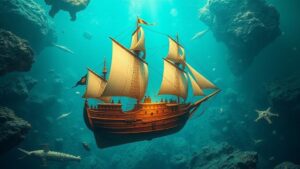How Shipwreck Salvage Logs Provide Clues to Remaining Maritime Relics
Introduction
Shipwrecks are often viewed as resting places for lost vessels, but they are also potential treasure troves of historical and archaeological significance. Salvage operations inconsequentially conducted over centuries have left behind a rich log of maritime activity that can guide future research on remaining relics. This article examines how shipwreck salvage logs serve as invaluable resources for historians and archaeologists in uncovering clues about maritime relics, with a focus on specific case studies and evidence.
The Importance of Salvage Logs
Salvage logs document the details of maritime salvage operations, including the types of artifacts recovered, the conditions of these efforts, and the locations of shipwrecks. Such documentation is crucial for several reasons:
- Historical Insight: Salvage logs provide a temporal snapshot of maritime practices, technology, and trade routes during specific periods.
- Site Preservation: They help researchers identify vulnerable sites that require protection or further study.
- Tracking Artifacts: Logs can trace the provenance of artifacts back to their origins, aiding in the establishment of historical narratives.
Case Studies of Salvage Log Usage
1. The Mary Rose
The recovery of the Mary Rose, a Tudor warship that sank in 1545 off the coast of Portsmouth, England, provides a compelling case study. shipwreck was salvaged in 1982, but prior records and salvage logs date back to the early 17th century when the ship was first discovered. These initial logs revealed the locations of various artifacts, such as weaponry and naval supplies, giving modern archaeologists contextual information about the ships operational history.
2. The USS Monitor
The USS Monitor was an American Civil War ironclad that sank in 1862 off the coast of Cape Hatteras, North Carolina. Salvage logs from both the 1970s and the recent recovery operations have provided integral insights into the condition and preservation-related challenges faced during salvage efforts. The artifacts recorded in these logs, including the ships revolving turret and cannons, guide conservation methods, ensuring that remnants are preserved accurately for future research.
The Role of Technology in Salvage Operations
Advancements in technology have transformed the field of underwater archaeology, allowing for more detailed and effective salvage operations. The use of sonar mapping, remotely operated vehicles (ROVs), and advanced diving systems has improved the ability to identify and document shipwreck sites as indicated in salvage logs. For example:
- Sonar Mapping: High-resolution sonar imagery assists teams in locating wreck sites, often revealing structures not documented in older logs.
- ROVs: Equipped with high-definition cameras, ROVs can explore and document artifacts in real-time, augmenting the data available from traditional salvage logs.
Challenges in Salvage Operations
While salvage logs provide critical information, the process is not without challenges. Some issues include:
- Record Preservation: Many historic logs are not digitized or have been lost, limiting the information available to researchers.
- Legal and Ethical Concerns: The ownership of salvaged artifacts and the legality of recoveries can complicate documentation and conservation efforts.
Future Research Directions
The ongoing study of shipwreck salvage logs holds immense promise for further maritime archaeology. Future directions may include:
- Digital Archives: Creating comprehensive digital repositories for salvage logs can enhance accessibility for researchers worldwide.
- Interdisciplinary Studies: Collaborating with historians, archivists, and marine scientists can yield new insights and methodologies for salvage projects.
Conclusion
Shipwreck salvage logs are invaluable artifacts in their own right, providing clues and context to remaining maritime relics. Through careful study and application of technology, these logs not only inform historical narratives but also shape future research directions in underwater archaeology. As the global community continues to strive for preservation and understanding of our maritime heritage, salvage logs will remain a cornerstone of this endeavor.
Actionable Takeaways
For researchers and enthusiasts interested in maritime archaeology:
- Seek out historical salvage logs and engage with institutions that hold such records.
- Use modern technology to complement traditional salvage and documentation methods.
- Collaborate across disciplines to harness a fuller understanding of maritime histories.


